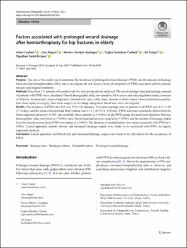| dc.contributor.author | Canbek, Umut | |
| dc.contributor.author | Akgün, Ulaş | |
| dc.contributor.author | Aydoğan, Nevres Hürriyet | |
| dc.contributor.author | Canbek, Tuğba Dübektaş | |
| dc.contributor.author | Turgut, Ali | |
| dc.contributor.author | Erciyes, Oğuzhan Samil | |
| dc.date.accessioned | 2020-11-20T14:39:22Z | |
| dc.date.available | 2020-11-20T14:39:22Z | |
| dc.date.issued | 2020 | |
| dc.identifier.issn | 0341-2695 | |
| dc.identifier.issn | 1432-5195 | |
| dc.identifier.uri | https://doi.org/10.1007/s00264-020-04738-z | |
| dc.identifier.uri | https://hdl.handle.net/20.500.12809/393 | |
| dc.description | Akgun, Ulas/0000-0002-5298-6559; DUBEKTAS CANBEK, TUGBA/0000-0002-3730-0029; Aydogan, Nevres Hurriyet/0000-0002-1837-2676 | en_US |
| dc.description | WOS: 000553737700004 | en_US |
| dc.description | PubMed ID: 32728927 | en_US |
| dc.description.abstract | Purpose The aim of this study was to determine the incidence of prolonged wound drainage (PWD) and the amount of drainage fluid after hip hemiarthroplasty (HA) and to investigate the risk factors for the development of PWD associated with the patient, fracture and surgical treatment. Methods Data from 313 patients who underwent HA were prospectively analysed. The mean drainage time and drainage amount of patients with PWD were calculated. Patient demographic data, pre-operative ASA scores and anticoagulation status, presence of diabetes, fracture type, surgical approach, femoral stem type, cable usage, amount of drain output, blood transfusion quantity, time from injury to surgery, time from surgery to discharge and patient blood tests were investigated. Results The incidence of PWD after HA was 8.9% (28 patients). The mean drainage time in patients with PWD was 4.9 +/- 1.85 (3-9) days, and the mean collected total fluid volume was 51.1 +/- 26.9 (21-132) mL. PWD was more commonly observed in the lateral approach group (p<0.001) and morbidly obese patients (p<0.001). In the PWD group, the mean post-operative first-day haemoglobin value was lower (p<0.001), more blood transfusions were required (p<0.001) and the amount of drainage output from the closed suction drain (CSD) was higher (p< 0.001). The duration of hospitalization was longer in patients with PWD (p< 0.001). Lateral approach, morbid obesity and increased drainage output were found to be associated with PWD in logistic regression analysis. Conclusion Lateral approach, morbid obesity and increased drainage output were found to be risk factors for the occurrence of PWD. | en_US |
| dc.item-language.iso | eng | en_US |
| dc.publisher | Springer | en_US |
| dc.item-rights | info:eu-repo/semantics/openAccess | en_US |
| dc.subject | Drainage Time | en_US |
| dc.subject | Drainage Volume | en_US |
| dc.subject | Hemiarthroplasty | en_US |
| dc.subject | Prolonged Wound Drainage | en_US |
| dc.title | Factors associated with prolonged wound drainage after hemiarthroplasty for hip fractures in elderly | en_US |
| dc.item-type | article | en_US |
| dc.contributor.department | MÜ, Tıp Fakültesi, Cerrahi Tıp Bilimleri Bölümü | en_US |
| dc.contributor.department | MÜ, Tıp Fakültesi, Dahili Tıp Bilimleri Bölümü | |
| dc.contributor.institutionauthor | Canbek, Umut | |
| dc.contributor.institutionauthor | Akgün, Ulaş | |
| dc.contributor.institutionauthor | Aydoğan, Nevres Hürriyet | |
| dc.contributor.institutionauthor | Canbek, Tuğba Dübektaş | |
| dc.contributor.institutionauthor | Erciyes, Oğuzhan Samil | |
| dc.identifier.doi | 10.1007/s00264-020-04738-z | |
| dc.identifier.volume | 44 | en_US |
| dc.identifier.issue | 9 | en_US |
| dc.identifier.startpage | 1823 | en_US |
| dc.identifier.endpage | 1831 | en_US |
| dc.relation.journal | International Orthopaedics | en_US |
| dc.relation.publicationcategory | Makale - Uluslararası Hakemli Dergi - Kurum Öğretim Elemanı | en_US |


















